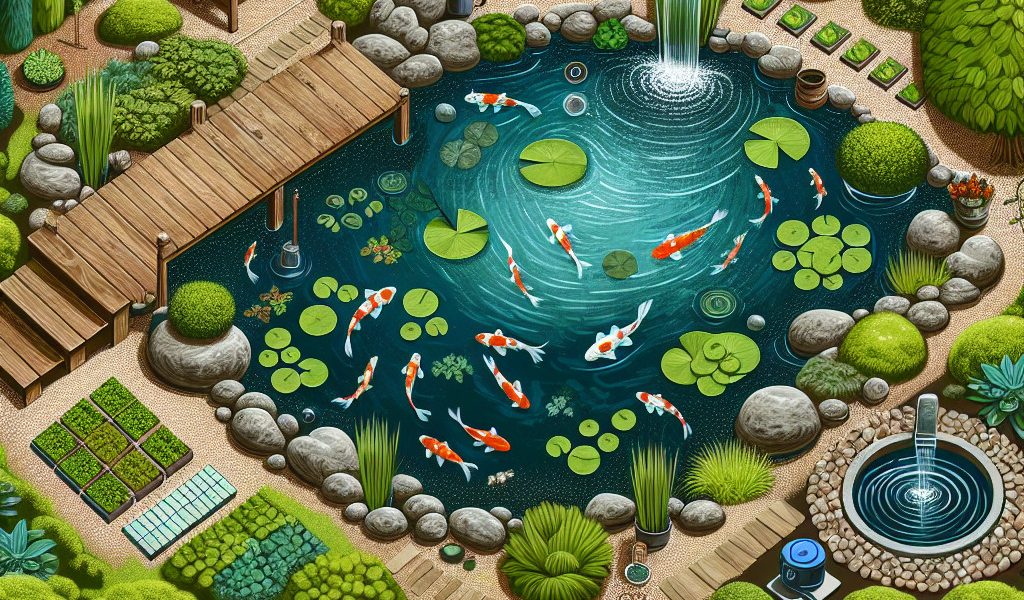Mastering the Art of Crafting and Outfitting Your Own Tranquil Garden Pond: A Comprehensive Guide
Introduction
A garden pond is an elegant and calming addition to any outdoor space. It can serve as habitat for fish, provide a focal point for the landscape, or simply provide a place to relax. In this guide, we’ll give you professional advice on selecting and installing a decorative pond, as well as tips for choosing the ideal location in your garden.
Choosing the size, shape and type of pool
Choosing the right type of pond will depend mainly on your personal preferences, but also on the general style of your garden. Here are some criteria to take into account:
- Size : The size of the pond will determine its visual impact in your garden as well as its capacity to accommodate various aquatic plants and fish. Also consider space constraints that may limit the maximum pool size.
- Shape : Natural shapes are generally more attractive and blend in better with the surrounding landscape. However, a geometric shape may be appropriate if it fits with the overall design of the garden.
- Kind : You can opt for an in-ground or above-ground pool depending on your aesthetic and functional preferences. An in-ground pond is generally more natural and can be integrated into the landscape, while an above-ground pond is easier to install and maintain.
Choice of construction material
Commonly used materials for constructing a garden pond include:
- Concrete : It offers great durability and can be molded into any shape. However, it requires professional work to install and can be expensive.
- Fiberglass or preformed plastic: These ponds are lightweight, easy to install and affordable. However, they may not be suitable for large projects due to size and shape limitations.
- Soft tarpaulin: EPDM or PVC rubber tarpaulins are flexible and allow for custom design. They are also UV and weather resistant, but require a little more effort to install than preformed options.
Installation of a preformed basin with a complete kit
To install a preformed pond with a complete kit, follow these steps:
- Decide where you want to place your pond taking into account the surrounding trees (to avoid dead leaves) and the risk of pollution from runoff (especially from fertilizers).
- Draw the shape of the pool on the ground with paint or a line, then dig using a shovel following the contours. Make sure the bottom is flat and horizontal.
- Place a layer of sand or geotextile felt at the bottom of the hole to protect the preformed shell from stones and other sharp objects.
- Insert the shell into the hole and check that it is level. Fill empty spaces around the hull with sand or soil, tamping regularly to avoid air pockets.
- Install a pump and filter if necessary, then fill the basin with water. Check for watertightness before adding aquatic plants and fish.
Landscaping around the pond
To create a natural and harmonious environment around your pond, consider adding:
- Aquatic plants : They contribute to the ecological balance of the basin by providing oxygen, shade and shelter for fish. Floating plants like water lilies are particularly appreciated for their decorative appearance.
- Fish: They add life and color to the pond while helping to control populations of harmful insects. Koi and goldfish are popular choices.
- Stones: They are used to delimit the pool and create a natural appearance. Flat stones can also be used to construct a shallow beach where birds can bathe safely.
- Fountains and waterfalls: These elements add movement to the water, creating a calming effect while improving the circulation of oxygen in the pool.
Conclusion
A well-designed and maintained garden pond can transform your outdoor space into a true haven of peace. By following these professional tips, you will be able to create a pond that perfectly matches your aesthetic tastes while respecting space and budget constraints. Do not hesitate to consult landscapers or pond specialists for personalized advice on your specific project.
